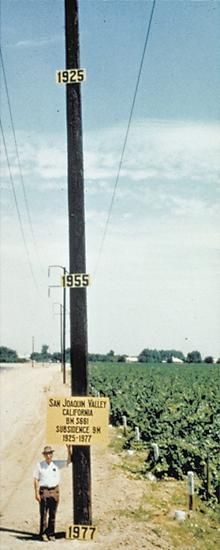
Now, for the first time this century, the entire state is in severe to exceptional drought.
"It's really depressing for us to leave ground out. We're still paying taxes and payments on everything that's non-production," said Gene Errotabere, whose family has farmed the valley since the late 1920s. "I mean, it's this whole valley. It's just a breadbasket of our whole country here, and to see this much ground being fallowed is not something I like to see."
Errotabere says his farm is in uncharted territory and on the verge of catastrophe. Thirty percent of his fields have been fallowed this year, and if these conditions continue, more growing operations could be shut down.
Comment: To help put this economic and ecological crisis into perspective, the following figures have been taken, by Newswatch, from Mother Jones:
The produce grown in the Golden State includes:
- 95 percent of America's broccoli crop
- 90 percent of its tomatoes
- 91 percent of its grapes
- 74 percent of its lettuce
- 99 percent of its walnuts
- 99 percent of its almonds
- 98 percent of its pistachios
- 99 percent of its walnuts
- 92 percent of strawberries
"If we have one more year like we had these past two years, it's going to be devastating out here. ... We'll probably have 60 to 65 percent of our production out next year."
The consequences are staggering near towns like Mendota. Dried-up fields blow dust into the sky. River beds and canals, once full of water, are now full of dead weeds and rattlesnakes. Fruit orchards along Interstate 5 look like burned piles of firewood. Workers who used to make a living picking fruit and working machinery now stand in government supported food lines to feed their families. No water means no jobs.
"This is the worst I've ever seen it. There's no water for anything."Jeff Holt, restoration biologist
Mendota Mayor Robert Silva doesn't mince words when discussing the disaster.
"Roughly about 40 percent unemployment ... it's higher than normal right now because of the water situation and farmers not planting. It's indication that it's going to be close to maybe 55 percent by the time situation is over.
"It's ugly to see people standing in line because they're out of a job."
Comment: While the drought obviously plays a large role in these unemployment numbers, the main culprit will continue to be the dynamic of greedy psychopaths in a society that cannot say no to them. The result is that society follows them off the cliff every time. For more information about this dynamic and how it affects each of us, check out:
Earth Changes and the Human-Cosmic Connection
The San Joaquin River runs through the heart of this arid growing region and in a normal year would flow with fresh snow melt from the Sierra. But there's little snow in the mountains, and little water in the river.
"Imagine washing the dirt off your driveway. That's what the water is like in the San Joaquin River," said Jeff Holt, a restoration biologist with River Partners in California, who got emotional when he looked at what's left of the river. "This is the worst I've ever seen it. There's no water for anything."
To combat drought conditions, farmers and cities use water wells to tap underground aquifers. But those aquifers are overused and the rapidly declining water levels are causing the once water rich cavities to collapse in a process known as subsidence.
A recent report from USGS hydrologist Michelle Sneed paints a grim picture: A valley the size of Rhode Island is sinking.
"About 11 inches a year ... is among the fastest rates ever measured in the San Joaquin Valley," she said. "It's a very large subsidence bowl. We were also surprised the high rate of subsidence."
It's irreversible damage. One area near Mendota is nearly 30 feet lower than it was in 1926, increasing the risk for infrastructure damage and even severe flooding in the future.
"This subsidence is permanent," said Sneed. "If water levels come back up, the subsidence will not be recovered. The land will stay subsided."



This dry of a year has not been seen since the latter half of the 1870's. The old timers spoke of it. Before that it was in 1844 as related by the Indians. The planners of the Central Valley project were well-aware of the limitations of water for irrigation.
But the PTB are more interested in Profits, and care nothing for the land. Even with the debasing of the the Trinity watershed through an 11-mile tunnel to Redding, delivering a million acre feet per year at the expense of a 2 billion/year fishing industry was nothing to them. And they're still at it draining the last 700,000 acre feet to the valley, with a meager release to the Trinity River for the salmon run.
No efforts were ever made to replace the groundwater during wet years, though the technology and the process is quite simple. Again, they don't care. Ageing Levee System, dams mean nothing, and they kick the can down the road every time without fail.
Out of work, needing a job? Do you lack any shred of conscience?
Uncle Bureacracy wants you, to serve in the Army of Planetay Abusers.